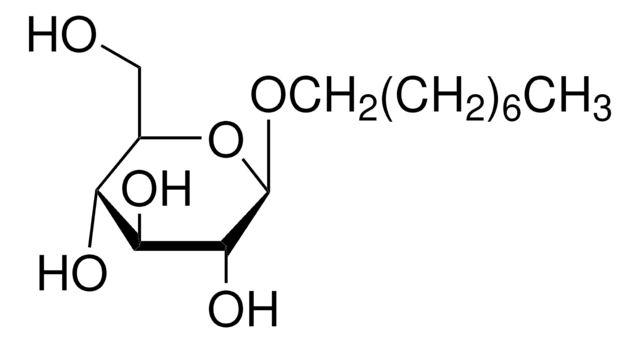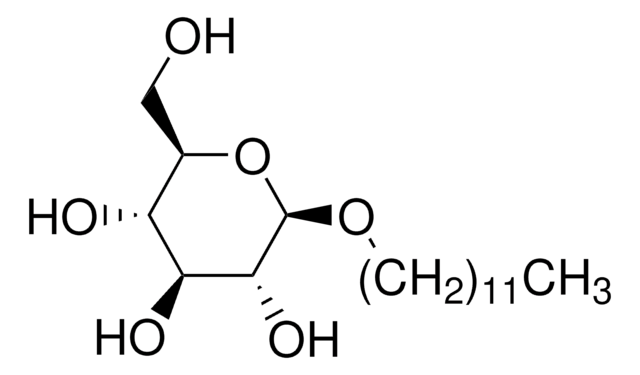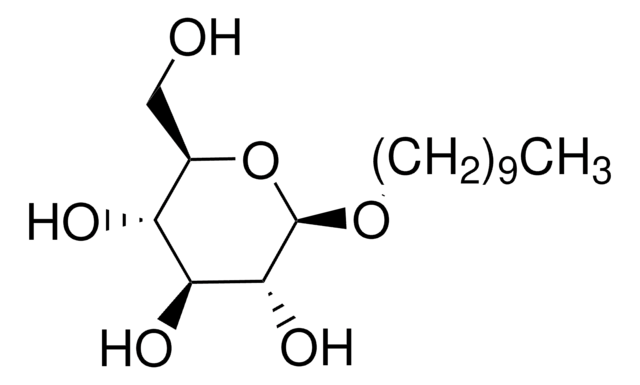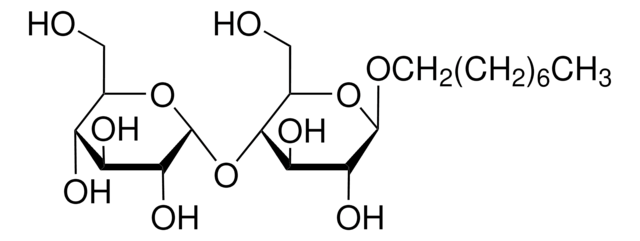10634425001
Roche
Octyl β-D-glucopyranoside
non-ionic
Synonyme(s) :
n-Octyl glucoside, OGP
About This Item
Produits recommandés
Essai
99% (GC)
Poids mol.
micellar avg mol wt 25,000
292.4
Conditionnement
pkg of 10 g
Fabricant/nom de marque
Roche
Nombre d'agrégation
84
Technique(s)
dialysis: suitable
CMC
20-25 mM (20-25°C)
Température de transition
cloud point >100 °C
Conditions d'expédition
ambient
Chaîne SMILES
CCCCCCCCO[C@@H]1O[C@H](CO)[C@@H](O)[C@H](O)[C@H]1O
InChI
1S/C14H28O6/c1-2-3-4-5-6-7-8-19-14-13(18)12(17)11(16)10(9-15)20-14/h10-18H,2-9H2,1H3/t10-,11-,12+,13-,14-/m1/s1
Clé InChI
HEGSGKPQLMEBJL-RKQHYHRCSA-N
Vous recherchez des produits similaires ? Visite Guide de comparaison des produits
Description générale
Application
Qualité
Ease of removal*: ++
CMC**: 14.5 mM at +25°C
Formula: C14H28O6
Notes préparatoires
Working solution: Solubility: > 50% (w/v) in double-dist. water, Tris-HCl 0.05 mol/l; pH7.4 or K-phosphate buffer 0.1 mol/l, pH 7.0 at 25 °C.
Storage conditions (working solution): Stability in Solution
A stock solution is stable at 2 to 8 °C for approx. 3 days. We would expect a long term stability of 6-12 months if stored frozen in portions at -15 to -25 °C, provided bacterial contamination is avoided.
Stockage et stabilité
Autres remarques
Code de la classe de stockage
11 - Combustible Solids
Classe de danger pour l'eau (WGK)
WGK 1
Point d'éclair (°F)
Not applicable
Point d'éclair (°C)
Not applicable
Faites votre choix parmi les versions les plus récentes :
Déjà en possession de ce produit ?
Retrouvez la documentation relative aux produits que vous avez récemment achetés dans la Bibliothèque de documents.
Les clients ont également consulté
Notre équipe de scientifiques dispose d'une expérience dans tous les secteurs de la recherche, notamment en sciences de la vie, science des matériaux, synthèse chimique, chromatographie, analyse et dans de nombreux autres domaines..
Contacter notre Service technique











